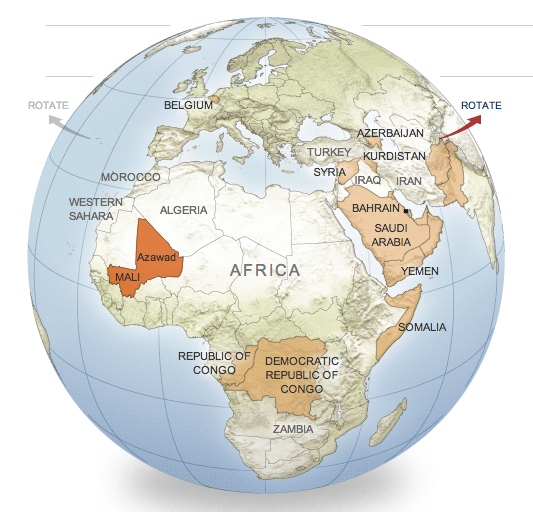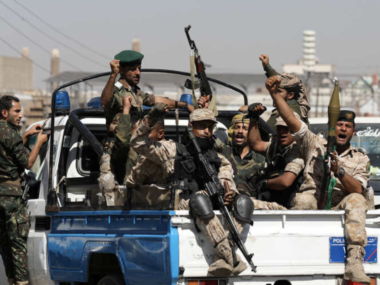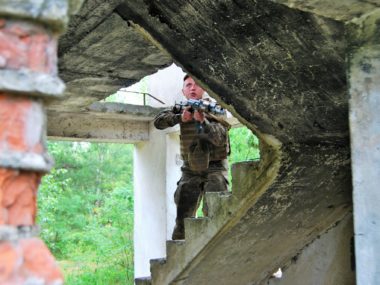A few years back Claude Berrebi and I attended a conference on terrorism at UC San Diego, and got to talking about the differences between countries that experience civil war and countries that experience terrorism. This discussion prompted Claude to brink up a pattern he’d observed. “You know Barb,” he said, “weak, poor states tend to be the target of civil wars. Rich, strong states tend to be the target of terrorism.”
So our puzzler today is this: Assuming this pattern is true (and we welcome any evidence that it is), why are different types of countries targeted with different types of violence?






0 comments
I think the following paper is a good starting point as it provides some empirical evidence for the idea that terrorism is a problem of richer/stronger countries: http://jcr.sagepub.com/content/56/4/580.short
You are equating a definition of conflict based on its participants with a tactic used in virtually all conflicts. Now, if you are specifically referring to organized transnational terrorism, the kind Al Qaeda uses, then targets tend to be large, rich, democratic, militarily powerful ones because those are the ones who have routinely intervened in their politics, and asymmetry leaves terrorism as the lone effective tactic. But Robert Pape has pretty much spent the last decade showing that terrorism affects a wide socioeconopolitical variety of countries. And to push the point that terrorism is a tactic even further, here is a list of terrorist bombings in Syria over the last year: http://en.wikipedia.org/wiki/List_of_bombings_during_the_Syrian_civil_war
I think I have this one. It’s about surplus – ie, resources a society produces above subsistence level.
In poor societies, there is not very much surplus. It tends to flow only to a small number of individuals, usually those who control the state apparatus or who are part of the coalition that supports the current political status quo. So people who want to go from no surplus to some surplus have to wrest control of the state away from the dominant coalition.
In rich societies, almost everyone has some surplus, and lots of people have lots of surplus. Therefore, while controlling the state apparatus might bring different levels of surplus, it’s a much more marginal equation. However, because everyone has a surplus, everyone has “something to lose.” Aggrieved actors both within and without the state know that basically having more surplus = more potential baseline levels of anxiety and therefore strategies that move that potential anxiety into kinetic anxiety (by making everyday life feel more dangerous) can affect state policy.
Am I on the right track?
At it’s simplest level this is a question of capabilities. By definition, a civil war requires the that opposition is capable of mustering an army — terrorism can be a single person. In wealthy countries “opposition” members sufficiently angry to consider violence are rare, or come from abroad as in the case of 9/11. There’s simply no question of them reaching the capability level necessary for a civil war. Terrorism is the recourse of the weak.
I think there are two possible explanations for this pattern of violence. A first explanation stems from the end the perpetrator tries to achieve. Usually, in the case of terrorist attacks, the perpetrators use them to send a message and instill fear in the population rather than trying to achieve a certain goal. On the other, in cases of violence wars, the opposition seeks to overthrow the government, get access to mineral resources or both. In the later case, the objectives are more farfetched and more easily countable than in the case of the terrorist attacks. Furthermore, rich states are characterized by increased levels of democracy, although not all the times, which bring about the possibility to challenge the state through non-violent means. Violent means are more costly in terms of audience costs in the case of rich countries. The second explanation is two-fold and it stems from this very point, the costs of organizing a terrorist attack or an insurgency. The former is far more costly and logistically difficult than the later. An insurgency or a rebellion depends greatly on its support base which is more difficult to achieve through violent means in a rich state. When a state redistributes its wealth, its citizens will be less inclined to support a rebellion or insurgency against it. The other part of part of the cost argument is that a rich state has greater control over its territory hence the possibility to organize a rebellion is greatly reduced. For a rich state it will be more easily to crush a rebellion because it has the resources, capacity and the information it needs to do so. Terrorist don’t have these types of constraints. Their operations are isolated, well-targeted and not so numerous so a state could follow any repression pattern in order to crush them.
Generally the statement is correct because of opportunity structures. It is difficult to wage guerrilla warfare in a developed country for a number of reasons, so actors substitute terrorism for guerrilla warfare. The PLO tried to wage traditional guerrilla warfare but failed. Same with the Montoneros. Regarding large-n research, there is not always a consistent positive relationship between GDPPC and terrorism, but it often shows up. See also the positive relationship often found between state capacity (CINC) and terrorism. There are exceptional cases, and measurement issues, but generally this seems to hold. Some of the best work on this subject is by de la Calle and Sánchez-Cuenca, as well as Findley and Young.
I’d worry about the tautological nature that starts with claims about the strength of the state such that civil war is evidence of the weakness of the state itself, therefore a “strong state” cannot collapse into civil war. Unless by “strong state” you are referring to the relative strengths of the state apparatus and its civil society. If the latter is the case, then you presuppose a civil society where change cannot be effected through competing political parties, elections, and/or social mobilization. In that case, calls for political change are not legitimated and all acts of violence to effect political change are “acts of terrorism.” The more marginalized these groups and the larger the power differentials between political reformers and the state, the more extreme the political violence needed to gain concessions from the state.
I agree with J Wells – the premise is simply wrong. By far the group who has been most affected by terrorism are poor people in poor countries. This is certainly the case in both numbers of people killed and numbers of single attacks.
Also should note that in many poor countries terrorism and civil war go hand in hand: e.g. Afghanistan, Sri Lanka, Somalia. They are simply different tactics of violence (and this is especially the case if we take a broader definition of terrorism, e.g. rebel attacks on civilians in DRC). Sometimes they are both used by the same actors (e.g. Al-Shabab, Tamil Tigers) and sometimes each used by different actors operating in same context (e.g. Syria).
However – and this is where I think Taylor Marvin is also partially correct – clearly the likely success of an armed rebellion (thus leading to civil war) differs greatly between rich countries (low) to poor countries (higher). In rich countries the state’s capacity to put down an uprising and its wider monopoly of violence mean that descent into open civil war is near-impossible. Thus, when armed violence does occur, it is more likely to take the form of a terrorist attack. In poor countries, with weak capacity, both terrorism and civil war are equally likely.
On Fri, Dec 14, 2012 at 11:01 AM, Political Violence @ a Glance wrote:
> ** > politicalviolenceataglance posted: “By Barbara F. Walter A few years > back Claude Berrebi and I attended a conference on terrorism at UC San > Diego, and got to talking about the differences between countries that > experience civil war and countries that experience terrorism. This > discussi”
Yes, I think Taylor Marvin and squarelyrooted are both on the right track.
If you are an revolutionary in Mali, you might have a shot at challenging state power in a full-blown civil war. If you’re a revolutionary in northern Spain, you know there is no way in hell you will defeat the Spanish state through force, so you have to limit your tactics to car bombs, assassinations, and so on: the recourses of the weak, as Taylor Marvin points out.
There is another important vector which is what squarelyrooted hints at (I think). Spain, even in the most pro-Basque regions, has a relatively large group of people who are relatively happy with the status quo and do not wish to risk their lives in order to achieve change. Mali, on the other hand, is bound to have much more social discontent, economic inequality, and grievances in general. Therefore, while you might get 200 crazy Basques to use violence for political goals, that is hardly enough to pose a challenge to the state. In Mali, the amount of people willing to employ violent tactics is likely to be higher – many have nothing to lose – and therefore it is possible to recruit enough members to turn the situation into a civil war.
I think that poor and (more importantly) weak states are more likely to experience both civil wars and terrorism. We just tend not to count it in these cases. If we define terrorism as politically motivated violence against civilian population, perpetrated by non-state actors, where do we see more of these (let’s say, in the last decade): In Western Europe, North America, and Japan, or in Sub-Saharan Africa, Pakistan, and Iraq? Even counting 9/11, I think the answer is clearly the latter…
Many studies have reasonable explanations for the link between state weakness and internal conflict (e.g., Barry Posen’s internal security dilemma, and Fearon and Laitin’s supply-side theory of insurgency). But in most places where we see civil wars we also see terrorism, and more frequently than in strong and rich states. I think, then, that the actual picture is this: we see both civil wars and terrorism more in weak states than in strong ones. But while civil war is rare in strong states, terrorism still occur in such places as well.
I think J Wells and Boaz have hit the nail on the head. Even most of Al Qaeda’s attacks have been in poor or weaker states – the Philippines, Kenya, Tanzania, Pakistan, Yemen, Indonesia, Iraq. The latter of course has been plagued with terrorism as a civil war tactic by all sides. In this Iraq’s is no different from civil wars fought in Latin America or Africa. Terrorism is a type of civil war violence, and while its logic may be somewhat different outside of civil war, it still tends to be employed primarily within poorer countries with softer capabilities. We just only tend notice it on the relatively rare occasions when a terrorist attack occurs in a wealthy state.
State capacity + number of deprivated social groups. The relevant correlation to explore seems to be the one in between GDPperCapita and civil war outbreak. Terrorism and large scale civil warfare are sometimes conducted by different actors, probably for different strategic reasons. Therefore the observed pattern needs to be qualified.
I’ll echo the fact that poor states are victims of terrorism as much, if not more so, than rich ones. It seems fairly obvious why rich, stronger states have fewer civil wars.
Otherwise, it does seem right to me that the nature of state goes a long way in determining the type of rebel that will fight that state. Will Reno’s recent book, Warfare in Independent Africa, makes a very compelling argument in line with this idea.